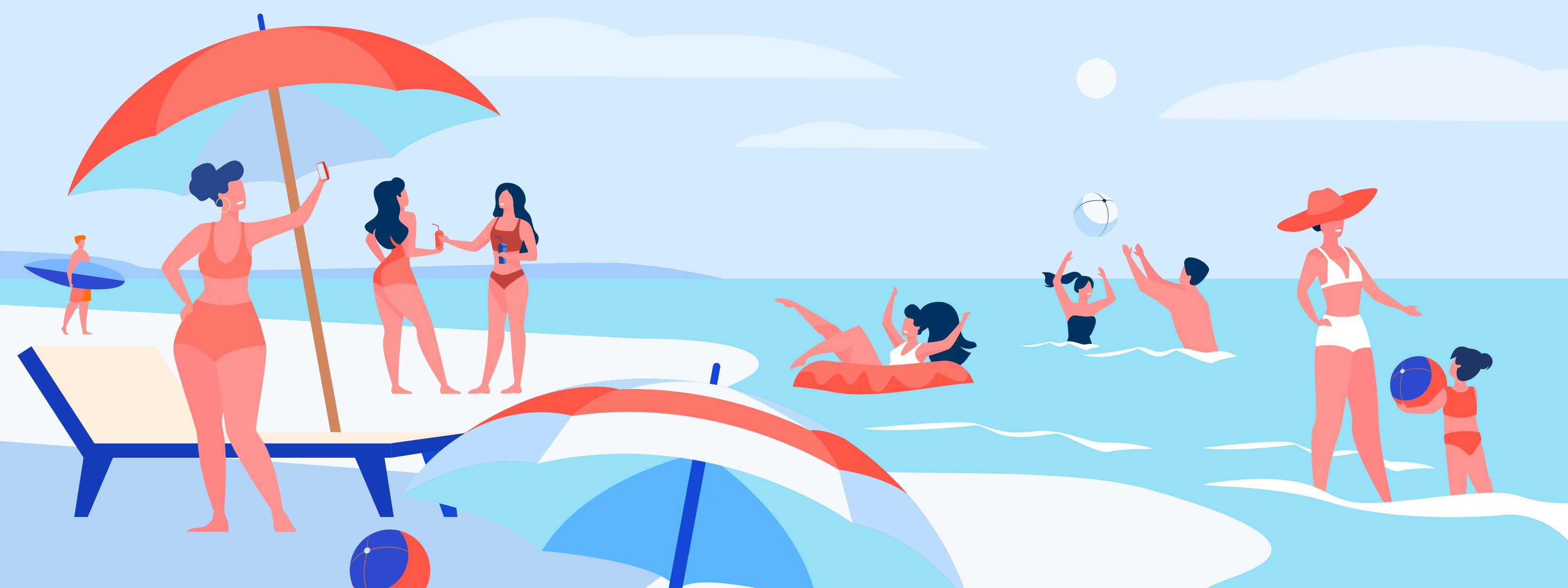1. Head to a lifeguarded beach
On a lifeguarded beach there are trained professionals to help keep you and your family safe – they’ll be on hand if something goes wrong, in or out of the water.
If you have any questions, or want advice on staying safe at the beach when you get there, go and have a chat with a lifeguard and they’ll be happy to help.
The RNLI has around 1,500 RNLI lifeguards (including volunteers) on over 240 beaches around the UK. To find your nearest lifeguarded beach, use our find my nearest lifeguarded beach tool.
2. Know what the signs and flags mean
On lifeguarded beaches, you will see flags up. It’s important to know what these mean, as they will indicate whether it’s safe to go in the water, and which activity it is safe to do, and where.
If you’re ever unsure, talk to one of our lifeguards who can help you.
Red and yellow flags
Meaning: Lifeguarded area. This is the safest area to swim, bodyboard and use inflatables.
Black and white chequered flags
Meaning: For surfboards, stand-up paddle-boards, kayaks and other non-powered craft. This is the launch and recovery area for kite-surfers and wind-surfers. Never swim or bodyboard here.
Red flag
Meaning: DANGER! Never go in the water under any circumstances when the red flag is flying.
Orange windsock
This indicates offshore or strong wind conditions. Never use inflatables when the windsock is flying.
3. Look out for rip currents and know how to stay safe
A rip current is a strong current running out to sea, which can quickly drag you out to sea.
Choose a lifeguarded beach and always swim between the red and yellow flags, which have been marked based on where is safer to swim in the current conditions.
If you do find yourself caught in a rip:
- Don’t try to swim against it or you’ll get exhausted
- If you can stand, wade don’t swim
- If you can, swim parallel to the shore until free of the rip and then head for shore
- Always raise your hand and shout for help
If you see someone else in trouble, alert the lifeguards or dial 999 or 112 and ask for the coastguard.
4. Swimming in the sea – consider your abilities
Before you or your family get in the water, it’s important to consider your ability and the conditions - the sea can be a very demanding environment and is different to swimming in a pool.
Every summer, the RNLI and Amateur Swimming Association (ASA) hold Swim Safe sessions for 7 - 14 year olds at selected beaches and lakes. The sessions are free and teach children vital skills to stay safe in and around open water. For your nearest Swim Safe lesson visit the website.
5. Make sure you and your family know what to do if you get into trouble
If you or your family get into trouble in the water, make sure you and your family know to dial 999 or 112 and ask for the coastguard. For more information, visit the Maritime and Coastguard Agency's website.
A whistle is a simple and effective method of calling for help when close to shore. When venturing further offshore carry a suitable means of calling for help, such as a waterproof and fully charged VHF, or flares.
Don’t forget the international distress signal of hand waving and shouting for help.
6. Inflatables
Inflatable toys and airbeds can easily be swept out to sea. Seek advice from lifeguards to check if the beach and conditions are suitable.
If there is an offshore wind, don’t go out on inflatables. On a lifeguarded beach, look out for the orange windsock and don’t use inflatables if it’s flying.
If you do use inflatables at the beach:
- Ensure children are closely supervised
- Keep near the shore
- Only use between the red and yellow flags
- Follow the lifeguard’s advice
- Do not take out in big waves
- Never use them when orange windsock is flying – this indicates offshore winds which will blow inflatables further out to sea.
7. Stay safe when bodyboarding
If you’re at a lifeguarded beach, make sure you always bodyboard between the red and yellow flags.
Always wear your leash and hold onto your board if you get into trouble – it will help you float.
Check the local forecast for wind, tide and swell.
8. Know what to do if your child goes missing at the beach
Children are safest when supervised.
As soon as you get to a beach, agree a meeting point in case of separation. If the beach runs a children’s safety scheme, using wristbands or tickets, take part. They’re free and they work. If you’re on an RNLI lifeguarded beach, visit the lifeguard hut on arrival and they can give you special wristbands to put your contact details on.
Make sure your children know where the lifeguards are, and that if they find themselves lost, to go and find a lifeguard as they will be able to help reunite them with you.
If a child does go missing:
- Calmly check your surroundings first, ensuring other children remain supervised
- Contact the lifeguards or police and keep them informed
- Let all searchers know once the child is found
9. Stay safe in the sun
The sun and UV (the strength of the sun) can be high at many times of the year, it doesn't have to be hot or there may be cloud cover, so it is important that you check the forecast throughout the year and in different weather conditions. Make sure children are covered up where possible, and have a good high factor sun cream on. Always reapply after being in the sea and regularly throughout the day.
-
Sunscreen –reapply SPF 30+ broad-spectrum waterproof sunscreen every two hours
-
Sun hat – put on a broad-brimmed hat that shades your face, neck and ears
-
Sunglasses – wear wrap-around sunglasses with UV protection to shield your eyes
-
Shoulders –put on a T-shirt or UV protective suit for children and remember to keep your shoulders covered
-
Shade – seek shade, particularly during the hottest time of the day between 11am and 3pm when UV penetration is at its strongest.e
Get UV and weather forecasts for UK and worldwide locations on the Met Office app. The UV forecast shows the UV index for the next 7 days.
10. Don’t get cut off by the tide
A beach can seem like a vast playground but the tide can come in surprisingly quickly. To avoid getting cut off by the tide:
- Before you head out, make sure it’s safe. Check the tide tables.
- While you’re out, be aware of your surroundings and the tide’s direction.
- If you do get cut off by the tide, dial 999 and ask for the coastguard.
For more information, visit the RNLI website, the Maritime and Coastguard Agency's website and respectthewater.com











